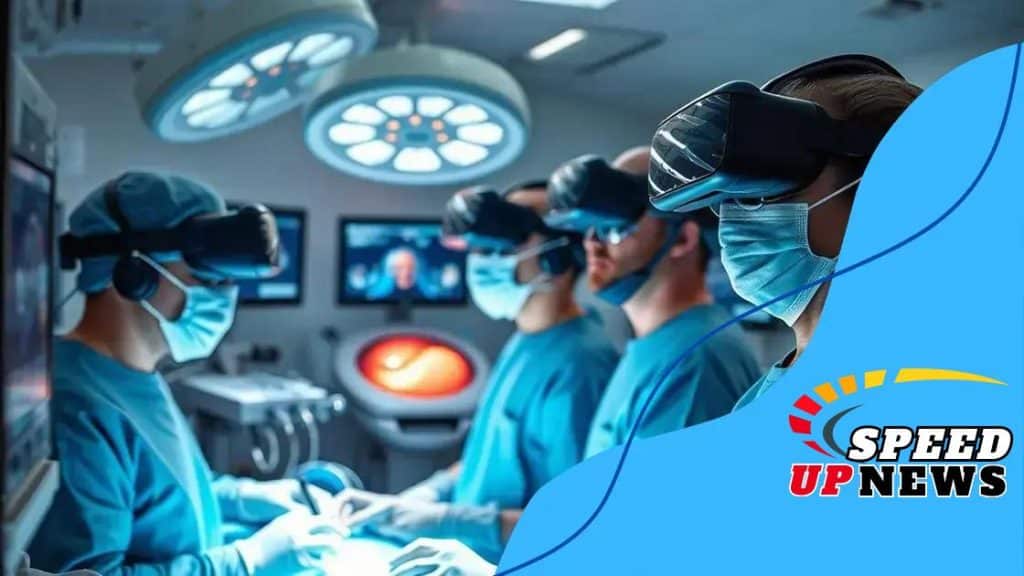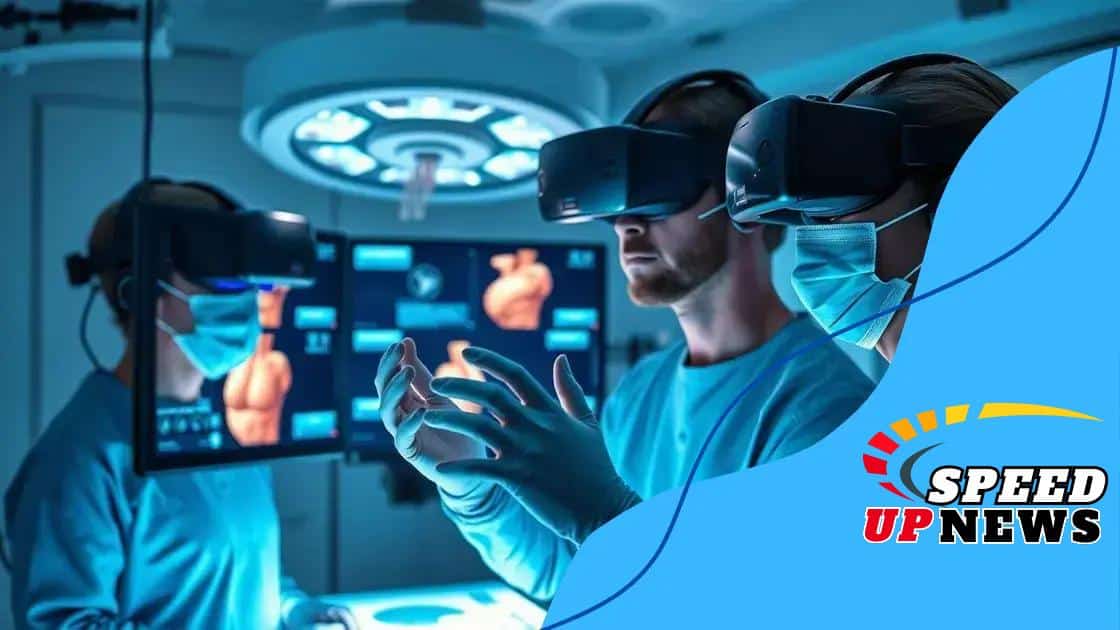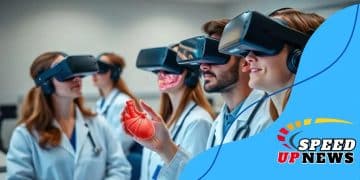Virtual reality for remote surgery training: a game changer

Virtual reality for remote surgery training revolutionizes medical education by providing immersive simulations that enhance skills, increase accessibility, and effectively prepare healthcare professionals for real-life surgical scenarios.
Virtual reality for remote surgery training is reshaping how surgeons learn and practice skills. Imagine gaining hands-on experience in a lifelike environment without risks to patients. Let’s dive into this innovative approach and explore its potential.
Overview of virtual reality in medical training
Virtual reality is transforming medical training by providing immersive experiences that enhance learning. With VR, medical students and professionals can practice procedures in a controlled environment, gaining confidence and skills without risks to real patients.
Key Features of Virtual Reality in Medical Training
One of the vital aspects of virtual reality is its ability to simulate realistic scenarios. Trainees can explore complex surgical procedures from multiple angles. This unique approach allows for greater retention of knowledge and skills.
- Realistic simulations of surgery.
- Hands-on practice without patient risk.
- Immediate feedback on performance.
Another significant benefit of VR training is accessibility. Students can engage in these experiences from anywhere, making it easier for remote learners to join. This is especially helpful for those in rural areas where hands-on training might be limited.
Benefits of VR in Medical Training
The integration of virtual reality in medical education has several advantages. First, it creates an engaging learning atmosphere. Learners retain more information when they are actively involved in their education.
- Enhanced engagement through interactive elements.
- Flexible learning schedules.
- Cost-effective compared to traditional methods.
Moreover, virtual reality for remote training fosters collaboration among students and instructors, allowing real-time feedback. This interactive nature promotes discussion and deeper understanding.
Benefits of virtual reality for remote surgery
The benefits of virtual reality for remote surgery training are vast and transformative. With VR technology, surgical practices can be simulated, allowing for safe and efficient training. This approach not only enhances learning but also significantly reduces risks associated with training on live patients.
Enhancing Surgical Skills
Virtual reality offers an immersive experience that helps trainees develop and refine their surgical skills. Participants can practice intricate procedures multiple times, gaining comfort before performing on real patients. The realistic feedback provided through these simulations allows for adjustment and improvement.
- Safe practice environment.
- Repetition aids skill mastery.
- Real-time feedback on techniques.
Moreover, VR technology allows for training in a variety of environments and scenarios. Surgeons can practice in simulated high-pressure situations, preparing them for real-life emergencies.
Cost-Effectiveness and Accessibility
Implementing VR into surgical training can lead to significant cost savings for medical institutions. Training can occur without the need for physical resources like cadavers or specialized equipment. Additionally, the ability to train remotely makes access to education easier for many students.
- Reduced costs of training materials.
- Flexible scheduling for learners.
- Access from remote locations.
Another benefit is the collaboration opportunities VR provides. Multiple trainees can join from different locations, engaging in group practice sessions that foster teamwork and shared learning experiences.
Technologies behind virtual reality surgery training

The technologies behind virtual reality surgery training play a crucial role in enhancing medical education. Key components include sophisticated hardware and software that create realistic simulations for surgical practice. By using cutting-edge technology, trainees can immerse themselves in a virtual environment that mimics real-life situations.
Key Components of VR Systems
One primary technology driving this innovation is virtual reality headsets. These headsets offer an immersive visual experience, allowing users to see and interact with three-dimensional environments. Another important component is the motion tracking systems, which detect hand movements to create a natural sense of action in the VR space.
- High-resolution displays for clear visuals.
- Real-time motion tracking for accurate interaction.
- Interactive haptic feedback devices.
Additionally, advanced software applications are designed specifically for surgical training. These applications simulate various surgical procedures and scenarios, providing instant feedback on performance. This feedback helps trainees improve their techniques and approach.
Integration of Artificial Intelligence
The integration of artificial intelligence (AI) into VR training enhances the learning experience. AI algorithms can analyze trainee performance, offering personalized recommendations for improvement. This tailored approach makes learning more efficient and effective.
- Adaptive learning paths based on trainee progress.
- Data analysis for performance tracking.
- Simulation adjustments to match trainee skill levels.
These technologies combine to create a comprehensive training platform that not only benefits individual learners but also prepares healthcare professionals for the demands of modern medical practice.
Challenges in implementing VR in surgical education
Implementing virtual reality in surgical education comes with its own set of challenges. While the benefits are significant, there are hurdles that institutions must navigate to successfully integrate this technology into training programs.
Cost and Funding Issues
One major challenge is the high cost of VR technology. Investing in state-of-the-art headsets and software can put a strain on budgets, especially for smaller training programs. Many institutions may struggle to secure funding for these resources.
- Expensive initial investment for equipment.
- Ongoing costs for software updates and maintenance.
- Lack of budget allocation for emerging technologies.
Another obstacle is the need for suitable infrastructure. Not all facilities are equipped to support the necessary technology, which can lead to inconsistencies in the training experience.
Training the Trainers
Furthermore, there is a significant need for instructors who are proficient in using VR systems. Many existing faculty members may require training themselves to effectively teach using these new tools. Without adequate training, the effectiveness of VR education may be compromised.
- Requirement for ongoing faculty development.
- Difficulty in finding qualified instructors.
- Challenges in integrating VR into existing curricula.
Lastly, there can be resistance from both faculty and students who are accustomed to traditional teaching methods. Overcoming this resistance requires careful adaptation and showcasing the potential improvements in learning outcomes.
Future trends in virtual reality for healthcare training
Future trends in virtual reality for healthcare training promise to reshape how medical education is delivered. As technology advances, we can expect more immersive and customizable experiences that enhance learning outcomes. Innovation in this field is driven by ongoing research and the needs of modern healthcare.
Personalized Learning Experiences
One key trend is the move toward more personalized learning experiences. Instructors can tailor VR simulations to meet the specific needs of individual students, providing scenarios that align with their current skill levels. This customization leads to better engagement and understanding.
- Adaptive learning platforms that respond to student performance.
- Scenarios designed for specific medical specialties.
- Enhanced feedback mechanisms for individual progress.
Moreover, advancements in AI are enabling simulations that adjust in real-time, presenting challenges that keep learners engaged and on their toes.
Integration of Mixed Reality
Another future trend is the integration of mixed reality (MR) with traditional VR. MR allows for blending real and virtual elements, creating an enriched training environment. Trainees can interact with both physical objects and digital overlays, enhancing their learning experience.
- Increased interaction with real surgical instruments.
- More effective training for teamwork and communication.
- Real-world applications in simulated hospital environments.
This integration can help prepare students for real-life scenarios more effectively, bridging the gap between theory and practice.
Collaborative Training Platforms
Additionally, collaborative training platforms are on the rise. These platforms allow multiple users to interact in a shared virtual space from different locations. This fosters teamwork and communication skills essential in healthcare settings.
- Remote teams working together in simulations.
- Peer feedback during practice sessions.
- Expanded opportunities for mentorship.
As technology progresses, the potential for VR to revolutionize healthcare training will become increasingly evident, offering more effective and accessible education for future healthcare professionals.
FAQ – Frequently Asked Questions about Virtual Reality in Healthcare Training
How can virtual reality enhance medical training?
Virtual reality provides immersive simulations that allow healthcare professionals to practice surgical procedures safely and effectively, leading to better skill acquisition.
What are some future trends in VR for healthcare education?
Future trends include personalized learning experiences, mixed reality integration, and collaborative training platforms that foster teamwork among trainees.
What challenges come with implementing VR in surgical education?
Some challenges include high costs, the need for trained instructors, and resistance from those accustomed to traditional methods.
How does AI play a role in virtual reality training?
AI enhances VR training by providing real-time performance analysis and personalized feedback, helping trainees improve more efficiently.





